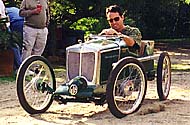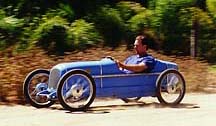





In light of the fact that more builders are starting projects, and in most cases we won't be able to supervise the concept development, we thought it might help if we shared some thoughts about improving the breed. For years we've held the position that racing improved car design for many years (the modern racecar is now a specialised machine which almost never generates spin-off technology for street cars.) While this may have been a good way to get a nice smooth-running, great-handling, dependable way to go get cappuccinos, we are of a very firm mind that this is not needed for CycleKarts. The very appeal of the CycleKart is based in large part on its visceral, spartan feel. It's super-quick steering, its nimble feel, the noise and dust; these are why people like driving them. We all have very capable cars nowadays with a great layer of insulation, in one way or another, from the road and the driving experience. Those who are attracted to the Cyclekart ideal are most likely hungering for a little more sensual driving feel than they get while zipping along the freeway.
Are we saying that the CycleKart is perfected? By no means. There's lots of stuff which comes up to fix and fiddle with. What we are saying is that we've spent decades thinking about the problem of why sports of many kinds start out fun and go downhill from there. We've built dozens of cars of all sorts of sizes and performance-levels in search of the most fun with the most congenial, least serious attitude. We've tried balls-out machines, electric vehicles (some of which would go over 100mph.), two wheels, three wheels, sailcars—all sorts of wheeled machines. We didn't just stumble on to the creation of the CycleKart, and we didn't stop there: we tried scaling up the machines, once we realised how fun they were, to try and see if we could take the fun out on the road (doesn't really work out; too similar to a minimal sportscar.) If you think this is a simple machine, you're right. If you think they're simply figured out, you're quite wrong. One mistake we think a lot of people make is thinking of CycleKarts in the same way they view autos in general. While these are four-wheeled machines (cars, obviously, but bear with us), they should be used as tools for fun, and very importantly: They should be viewed more as art projects than as cars. Racing around can be fun, but so can touring along looking at things. We've found that the best fun can be had in pursuit of real sport: chasing each other around the track, not caring who really wins, but sharing in the sport. If one thinks of racing, one tends to immediately slide off down a slope leading to competitive one-ups-manship, fraught with all the same stuff we're trying to avoid. Friendly competitveness seems to be good, but wanting to win at any cost isn't so healthy for the soul, we think. All of this becomes moot when you view these machines as pieces of driveway sculpture you can have fun motoring about in. If someone builds one, they should be starting from an aesthetic criteria. Even the performance has been shaped for effect, not "winning" or speed. The sensations are a key part of the art, and a vital part of the attrativeness of the machines.
Where, then, can one apply creative juices? Certainly in the sculptural arena, as the most important element of the attractiveness of the CycleKart is the visual. That's what attracted you, the reader, in the first place. You saw how cute these are. They're little toys you can ride in, and they should be cute. We think the Art Nouveau had it right: everything should strive to add beauty to the world (particularly these days, when we're living in a general culture of ugliness-as-intimidation). Another area is the reliability. They're pretty good, considering, but there are always ways to tune things up a bit. For example: after years of playing with our CycleKarts, we suddenly hit on some nice improvements like ways to start the engine without getting out of the car, better choke and throttle linkage arrangements, there's always a stray vibration to find and eliminate: Subtle things like this are a good way to spend time. If you really have the urge to build a lot, make another car!
The main thing is to guard against so-called improvements which may make the car perform better (though it's hard to do with the limited power), but ultimately detract from the whole gestalt of CycleKarting. You should be doing this for the sport and relaxation, not for the glory. If you're wanting to prove something, prove it to yourself somewhere else; we don't want to know about it!
We have so often had uninitiated, potential CycleKartistes say something like this to us after a few minutes of driving (and a few minutes of thinking about the whole affair): "I get it now. They don't need to be any better really. Sure you could make it fancier, but what would it help?"
One area of CycleKarting we think is a good place to "cheat" is in the weight. Lowering the mass of the car helps in just about every way. We've avoided putting a lower weight limit consciously, as this is a great place to make improvements. Hats off to the first builder who can break 200 lbs. (and still have their car survive a friendly run or two; I almost wrote "race", but that would connote the wrong idea a bit) I think a composite monococque car could pretty easily break 200lbs., but I've been more interested in making more new cars and not too interested in takin too much time going for a super-light trophy (seeing as how it really wouldn't make a huge difference, most likely; when the car weighs the same as the driver, a pound here or there isn't going to change things much...and we're not trying to "win" anyway)
So...Make a car, keep it simple and fun at first, and think really, really hard about whether the changes you make are really in the best interests of sport and art.
